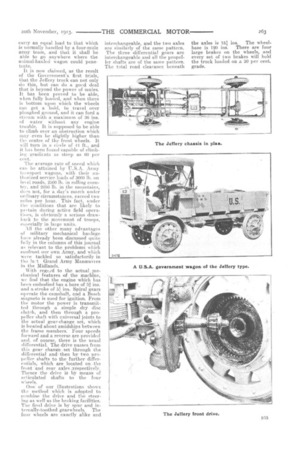U.S.A. W.D. Four-drive Lorries.
Page 6

Page 7

If you've noticed an error in this article please click here to report it so we can fix it.
At a time when users throughout the country are having their attention drawn to the require.. ments of the British War Office in respect of self-propelled lorries and to their efforts to secure suitable machines, it is not inappropriate briefly to refer to a special type of truck—as it is called—which has now been adopted by the United States Army authorities.
From a number of photographs which have come into our possession of the first serviefv:example of this class of constenction, we select four, :and reproduce them herewith. These are sufficient, at the moment, to indicate the class of machine which, has earned the approval of our American service friends.
It must be rather more than a coincidence that both the American and French military authorities are plumping at the same time for a four-wheel-drive vehicle. On the occasion of -our recent critical review of the commercial-vehicle exhibits at the Paris Exposition, we 1310
had occasion to remark on the growing popularity of the fourwheel-drive tractor in the hands of the French Army, and now we find the U.S.A. Wor Department having constructed, to its own requirements, a four-wheel steering and driving lorry, by the Thomas B. Jeffery Co., whose main office and works are at Kenosha, Wisconsin. The type may become standard. The first truck to be passed by the authorities has promptly bea.en shipped for service with the trocips-eonthe Mexican frontier, where the present disturbed conditions should afford ample opportunity for the testing of such a machine under practical conditions.
The whole design trf this interesting machine is based on the requirements that it shall be able ta carry an equal load to that which is normally handled by a four-mule army team, and that it shall be able to go anywhere where the anirnal-hauled wagon could penetrate.
It is now claimed, as the result of the Government's first trials, that the Jeffery truck can riot only do this, but can do a good deal that is beyond the power of mules.
It has been proved to be able, when fully loaded, and when there is bottom upon which the wheels can get a hold, to travel over ploughed ground, and it can ford a
stream with 41 maximum of 36 ins.
of water without any engine trouble. It is supposed to be able
to climb over an obstruction which may even be slightly higher than the centre of the front wheels. It will turn in a circle or 44 ft.' and it has been found capable of climbing gradients as steep as 60 per cent.
The average rate of speed which can be attained by U.S.A. Army
ansport wagons,' with their authorized service loads of 3000 lb. on level roads, 2500 lb. in rolling country, and 2000 lb. in the mountains, does not, for a day's march under ordinary circumstances, exceed two miles per hour. This fact, under the conditions that are likely to pertain during active field operations, is obviously a serious drawback to the movement of troops, especially in large units.
All the other many advantages of military mechanical haulage have already been discussed quite fully in the columns of this journal as relevant to the problems which confront our own Army, and which were tackled so satisfactorily in the hut Grand Army Manoeuvres in the Midlands.
With regard to the actual.mechanical features of. the Machine, we. find that the engine which has been embodied has a bore of 3*.•ins.• and a stroke of 31 ins. Spiral gears operate the camshaft, and a Bosch magneto is used for ignition. From th-n motor th.e power is transmitted through a simple dry disc clutch, and then through a propeller shaft with universal joints to the actual gear-change set, which is located about amidships between the frame members.' Four speeds forward and a reverse are provided and, of course; there is the usual di fferential The drive -passes from this gear change -.set through the differential and then by two pro prller to the furtherdifferertialswhich are located on the front 'and rear axles-41espectively. Thence the drive iS by means of articulated shafts to the four wheels.
One of our illustrations shows tha method which is adopted to combine the drive and the steering as well as the braking facilities.Tlie final drive is by spur and internally-toothed gearwheels. The four Wheels arc exactly alike and
interchangeable, and the two axles are similarly of the same pattern. The three 'differential gears are interchangeable and all the propeller shafts are of the same. pattern. The total road clearance beneath
the axles is 151 ins_ The wheel base is 120 ins. There are four large brakes oh the wheels, and every set of two brakes will bold the truck loaded on a 30 per cent. grade.






















